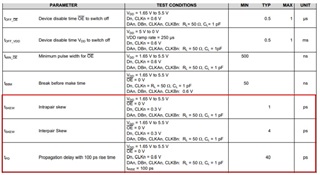hello team,
Please help if you know.
I would like to switch high-speed data of 10ch or more using multiple TS5MP645s.I would like to estimate the part to part skew in that case. But it's not mentioned in the specs.As an estimation method, there is a method of calculating the skew between parts using the maximum and minimum propagation delays and minimum and maximum skews, but the TS5MP645 specification only lists standard values for propagation delay and skew.


